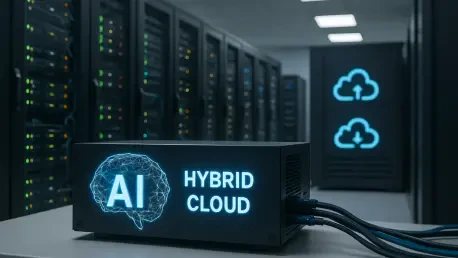In an era where digital transformation dictates the pace of business success, the convergence of artificial intelligence (AI), particularly generative AI (GenAI), and hybrid cloud infrastructure is redefining the enterprise IT landscape with unprecedented force. These technologies are not mere tools but fundamental drivers that are altering how organizations strategize, operate, and innovate in a competitive market. A recent executive roundtable hosted by Tech Monitor, in partnership with Lenovo and Intel at the South Place Hotel in London, brought together senior technologists to dissect this transformation. Their discussions unveiled a complex journey of technological adoption, marked by both enthusiasm and caution, as businesses navigate the promises and pitfalls of AI and cloud solutions. The insights shared underscored a pivotal shift toward hybrid models that balance scalability with control, while AI emerges as a catalyst for automation and insight. This evolving synergy is setting the stage for a new chapter in enterprise intelligence, prompting a deeper exploration of its implications.
Navigating the Cloud Journey
From Cloud-First to Hybrid Balance
The early days of cloud computing saw enterprises rushing toward a public cloud model, captivated by its promise of scalability, flexibility, and reduced upfront costs through pay-as-you-go pricing. This “cloud-first” mindset dominated strategic thinking, as businesses sought to offload infrastructure burdens and tap into seemingly limitless resources. However, the reality soon revealed significant drawbacks, including latency issues that hampered performance, escalating costs that strained budgets, and data sovereignty concerns heightened by regulations like the US CLOUD Act. These challenges prompted a reevaluation, as firms recognized that not all workloads thrived in a public cloud environment. The discussion at the roundtable highlighted this shift, noting how many organizations began to prioritize a more discerning approach, seeking solutions that could address these pain points without sacrificing the benefits of cloud technology.
This reassessment gave rise to hybrid cloud as a pragmatic compromise, seamlessly integrating public cloud resources with on-premise infrastructure through a unified interface. Hybrid cloud offers the best of both worlds—scalability for dynamic workloads and enhanced control for sensitive operations. A striking trend of workload repatriation emerged, where companies started moving certain applications back to on-premise environments after initial cloud migrations. This shift, driven by a careful analysis of cost, risk, and timing, reflects a maturing understanding of IT needs. The roundtable participants emphasized that repatriation does not signify a rejection of public cloud but rather a strategic realignment to optimize performance and security. As major hyperscalers continue to report robust growth, it’s clear that public cloud remains integral, yet the hybrid model is increasingly seen as the foundation for sustainable IT strategies.
Financial Realities of Cloud Adoption
Financial considerations have become a critical lens through which enterprises view their cloud strategies, often revealing a stark disconnect between technical ambitions and fiscal realities. A compelling anecdote shared during the roundtable illustrated this tension vividly: a senior technologist who migrated all workloads to the public cloud faced sharp scrutiny from the CFO, who pointed out that continuously rising IT expenses demanded proportional business growth to justify the spend—a guarantee that couldn’t be made. This scenario exposed the pitfalls of a cloud-only approach, where the allure of flexibility can mask the burden of unpredictable costs. Such experiences have pushed businesses to rethink their reliance on a single model, recognizing that financial sustainability must underpin technological innovation.
Hybrid cloud strategies have gained favor as a way to mitigate these financial risks, offering a framework where costs can be better managed by allocating workloads between public and private environments based on economic viability. The roundtable discussions underscored that while public cloud excels for certain scalable tasks, on-premise systems often prove more cost-effective for stable, predictable workloads. This balanced approach helps align IT spending with long-term business goals, avoiding the budget overruns that plague cloud-only setups. Moreover, the trend of workload repatriation serves as a corrective measure, allowing firms to reclaim control over expenses by bringing critical operations back in-house. This financial pragmatism is reshaping how enterprises architect their IT infrastructure, ensuring that innovation does not come at the expense of fiscal health.
Unleashing Potential with AI Innovation
AI Experimentation and Deployment
Artificial intelligence, with a spotlight on generative AI (GenAI), stands as a transformative force in enterprise IT, promising to revolutionize productivity, automate complex processes, and unearth actionable insights from vast data pools. The public cloud has emerged as an ideal testing ground for AI initiatives, enabling businesses to experiment with proofs of concept using small datasets at an accelerated pace. This environment offers the computational power and flexibility needed for rapid iteration, allowing organizations to explore AI’s potential without committing to hefty upfront investments. Roundtable participants noted that this sandbox approach has fueled early adoption, as firms can quickly gauge the viability of AI applications before scaling them into broader operations, making public cloud a critical enabler of innovation.
However, as AI projects move from experimentation to full-scale deployment, many enterprises encounter the limitations of a cloud-only model, particularly around cost management and data security. The shift to on-premise infrastructure often becomes necessary to address these concerns, providing tighter control over sensitive information and curbing the expense of sustained cloud usage. This lifecycle approach—starting in the cloud for agility and transitioning to on-premise for stability—mirrors broader trends in IT workload management. The concept of the “Trillion Dollar Paradox,” discussed during the event, encapsulates this dynamic: while initiating AI in the cloud is practical, long-term reliance may prove neither cost-effective nor strategically sound. The hybrid cloud thus plays a pivotal role, supporting AI’s compute-intensive demands by offering a flexible infrastructure that adapts to evolving needs.
Introducing Hybrid AI
The notion of hybrid AI, articulated by Lenovo’s Tikiri Wanduragala during the roundtable, presents a compelling parallel to the hybrid cloud model, framing AI adoption as a spectrum of tailored solutions. This framework categorizes AI into three distinct forms: embedded AI integrated into devices like translation apps, third-party AI applications that adapt existing tools or introduce new functionalities, and bespoke in-house AI solutions crafted for unique competitive advantages. Each form addresses different organizational needs, from immediate utility to strategic differentiation. The hybrid AI concept suggests that businesses can mix these approaches, much like hybrid cloud blends environments, to optimize outcomes based on specific goals and resources, paving the way for a nuanced integration of AI into enterprise systems.
Looking ahead, hybrid AI is poised to follow a trajectory similar to that of hybrid cloud, evolving through phases of experimentation, adaptation, and customization. Just as cloud strategies matured from an all-in public approach to a balanced hybrid model, AI adoption is expected to progress from reliance on accessible third-party tools to the development of proprietary systems that align with core business objectives. The roundtable consensus pointed to this evolutionary path as a means to harness AI’s full potential while mitigating risks like cultural resistance or skills gaps. By leveraging hybrid cloud as the underlying infrastructure, organizations can support the heavy computational demands of AI, ensuring scalability and control. This forward-looking perspective underscores hybrid AI as a blueprint for sustainable innovation in enterprise IT.
Regulatory and Strategic Considerations
Data Sovereignty and Compliance
As enterprise IT evolves with AI and hybrid cloud, regulatory pressures around data sovereignty and compliance have taken center stage, profoundly influencing infrastructure decisions. Concerns over data residency—where information is stored—and legal jurisdiction have intensified, particularly with frameworks like the US CLOUD Act, which allows access to data stored abroad without prior consent. Such regulations have heightened anxiety among firms, especially in regions with strict data protection laws, pushing them to prioritize solutions that ensure data remains within local boundaries. The roundtable discussions revealed a growing awareness of these issues, with many technologists advocating for setups that align with both operational efficiency and legal mandates, highlighting the critical intersection of technology and policy.
Hybrid cloud has emerged as a key enabler in addressing these regulatory challenges, offering the ability to localize data storage and management while still tapping into global cloud resources when needed. This flexibility allows enterprises to place sensitive workloads on-premise in compliance with regional laws, while leveraging public cloud for less regulated tasks. The trend toward localized control is not just a reaction to legal requirements but also a strategic move to build trust with stakeholders by safeguarding data integrity. Participants at the event emphasized that as regulatory landscapes become more complex, hybrid models provide a resilient framework to navigate these waters, ensuring that businesses can innovate without compromising on compliance. This balance is proving essential in an era where data is both an asset and a liability.
Strategic Alignment for Future Growth
Beyond regulatory imperatives, the strategic alignment of AI and hybrid cloud with long-term business goals was a recurring theme in the roundtable insights, reflecting a broader shift toward holistic IT planning. Enterprises are increasingly viewing these technologies as interconnected components of a larger ecosystem, where the success of AI deployment hinges on the robustness of hybrid cloud infrastructure. This synergy enables firms to tackle compute-intensive AI workloads while maintaining the agility to adapt to market changes. The strategic focus lies in crafting IT environments that support innovation without exposing the organization to undue risks, whether financial, operational, or reputational, ensuring a foundation for sustained growth.
Reflecting on the discussions held, it’s evident that the journey of integrating AI and hybrid cloud has been one of cautious optimism, marked by lessons learned from past cloud adoption waves. Enterprises have navigated the initial rush to public cloud, recalibrated through repatriation, and embraced hybrid models to balance their needs. The emergence of hybrid AI as a complementary concept has offered a roadmap for future innovation, tailored to diverse operational demands. As challenges like skills shortages and legacy systems persist, the consensus is that hybrid approaches provide a practical path forward. Moving ahead, businesses should prioritize building flexible infrastructures, invest in talent development for AI, and maintain vigilance on regulatory shifts to fully harness these technologies, setting the stage for a smarter, more resilient enterprise IT landscape.









